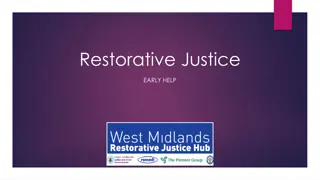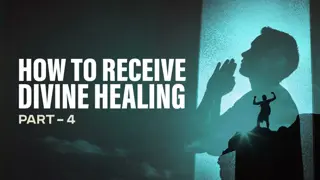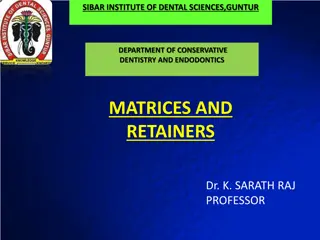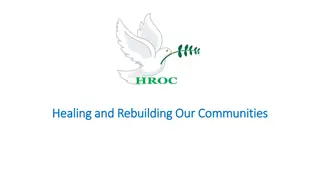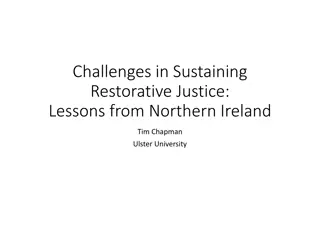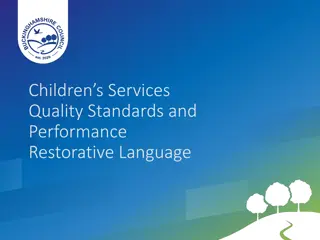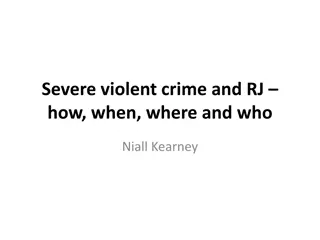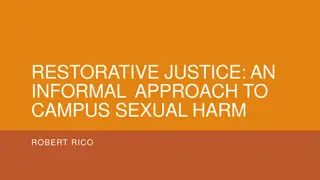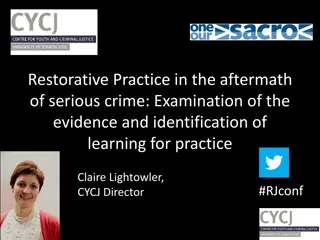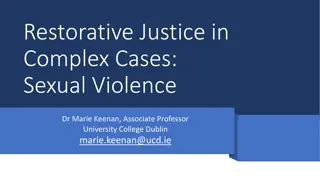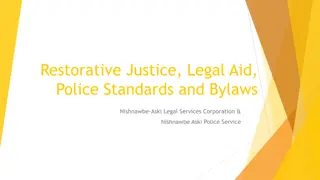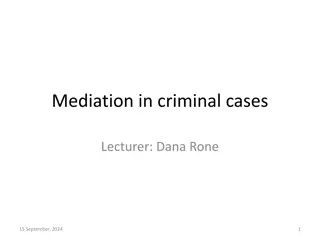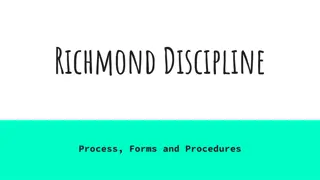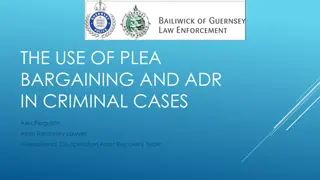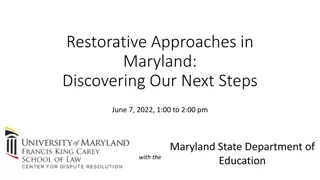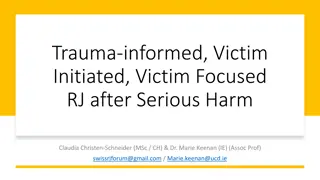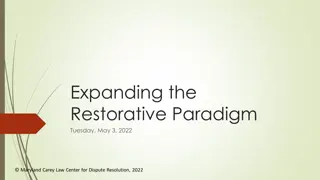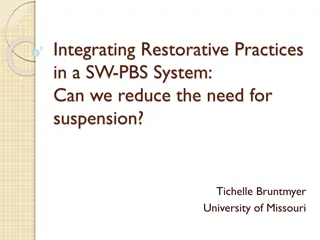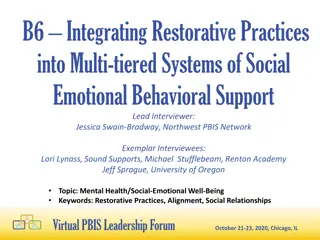Understanding Restorative Justice: A Path to Healing and Justice
Restorative justice is a transformative approach focusing on repairing harm caused by crime. It emphasizes meeting victim needs, offender accountability, and community involvement. This method, different from retributive justice, aims for full resolution and healing. Originating from indigenous practices and evolving over time, restorative justice offers a hopeful framework for the future of criminal justice.
Uploaded on Sep 13, 2024 | 0 Views
Download Presentation

Please find below an Image/Link to download the presentation.
The content on the website is provided AS IS for your information and personal use only. It may not be sold, licensed, or shared on other websites without obtaining consent from the author. Download presentation by click this link. If you encounter any issues during the download, it is possible that the publisher has removed the file from their server.
E N D
Presentation Transcript
RJ 101 An Introduction to Restorative Justice Restorative Justice and Restorative Practices Summit February 26, 2016 San Diego, CA Mary Acosta and Deacon Jim Walsh
What is Restorative Justice anyway? Restorative justice is An effective philosophy and a practical way to achieve justice A transformational approach to attain full resolution of harms An encouraging framework for the future of criminal justice Not soft on crime
Two Different Views Retributive Justice Restorative Justice Crime is a violation of the law and the state. Crime is a violation of people and relationships. Violations create guilt. Violations create obligations. Justice requires the state to determine blame (guilt) and impose punishment. Justice involves victims, offenders, and community members with the responsibility to put things right. Central focus: offenders get what they deserve. Central focus: victim needs are met and offender is accountable for repairing harms.
Definition of Restorative Justice Restorative Justice is a process to involve, to the extent possible, those who have a stake in a specific offense and to collectively identify and address harms, needs, and obligations, in order to heal and put things as right as possible - Howard Zehr
Four Key Aspects of the RJ Process 1) Encounter: creating opportunities for victims, offenders (wrongdoers), their families, and community members who want to meet to discuss the crime (harms, incident) and its impact on them. 2) Amends: expecting the wrongdoers to take steps to repair the harms they have caused. 3) Reintegration: seeking to restore victims and offenders to wholeness, to become contributing members of their communities. 4) Inclusion: providing opportunities for parties with a stake in a specific crime, harm or incident to participate in it s resolution. (adapted from RJ Online) Restorative Practices International, rpiassn.org
Restorative Justice Practices History Origin: Indigenous, community based cultures Rituals and cultural context are different but foundation of restoration is similar: Native American traditions, Canada (First Nations), New Zealand (Maori family group conferencing), Uganda (Mato Oput), Rwanda (Gacaca courts), and so many others 1970s in the U.S. Early victim/offender mediation programs in Mennonite communities (Indiana, USA) First restorative programs in schools
Goals of Restorative Justice Restorative Justice programs aim to : Put key decisions into the hands of those most affected by the harms Make justice healing and transformative for all stakeholders Reduce the likelihood of future offenses Achieving these goals requires that: Victims are involved in the process and are satisfied as a result Offenders understand how their actions have affected lives and take responsibility for those actions Outcomes help to repair the harms done and address the reasons for the offense Susan Sharpe, Restorative Justice: A Vision for Healing and Change
Spiritual Roots of Restorative Justice Shared values among major religions and spiritual traditions Restoration Reconciliation Healing Forgiveness Mercy Substantive, transformative justice Hope
Some Models of Restorative Justice Practices Victim offender mediation/dialogue/reconciliation Community Conferencing Circles Restorative conferences, classroom conferencing, community-building circles (in schools) Restorative Practices International, rpiassn.org
Benefits of participation in an RJ process Mutual understanding of the causation and ripple effect of harms Full, real resolution of harms Increased victim satisfaction with the justice system Reduced victim s post-traumatic stress symptoms Reduced repeat crime Increased rate of completion of restitution/restoration agreements Increased community safety and cohesiveness Cost-benefit to society, especially when used as a diversion
Restorative Practices Restorative practices is an emerging new field of practice and study that has its roots in restorative justice. The fundamental premise is that people are happier, more cooperative and productive, and more likely to make positive changes when those in positions of authority do things with them, rather than to them or for them. The focus of Restorative Practices is To develop community, build relationships and connections Manage conflict and tensions by repairing harm and rebuilding relationships Adapted from International Institute for Restorative Practices, iirp.edu
In schools, the use of restorative practices has been shown to reliably reduce misbehavior, bullying, violence and crime among students and improve the overall climate for learning.


